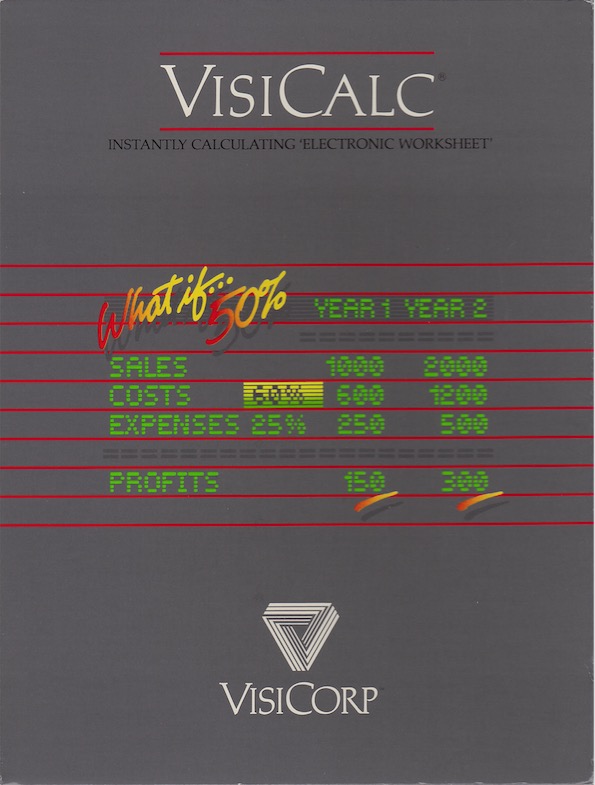
Cosmic Balance II, designed by Paul Murray from SSI, USA
First release : May 1983 on Apple II and Atari
Tested on : Apple and Atari emulators
Total time tested : 8 hours
Average duration of a campaign : Variable
Complexity: Average (2/5)
Would recommend to a modern player : No
Would recommend to a designer : No
Final Rating : Totally obsolete
Ranking at the time of review : 52/67
As usual, reviews assume you have read the AARs, in this case at least the first ones.
It all seemed obvious to SSI : the space-combat game the Warp Factor in 1981 had been a success, and its spiritual successor the Cosmic Balance was bound to be one as well. But both games felt incomplete, they lacked a reason to fight those space battles. They lacked, in two words, a strategic layer. That could be mended. Just as The Cosmic Balance was released, SSI announced the future release of a strategic-level game to be used as an “adjunct” : Cosmic Balance II.
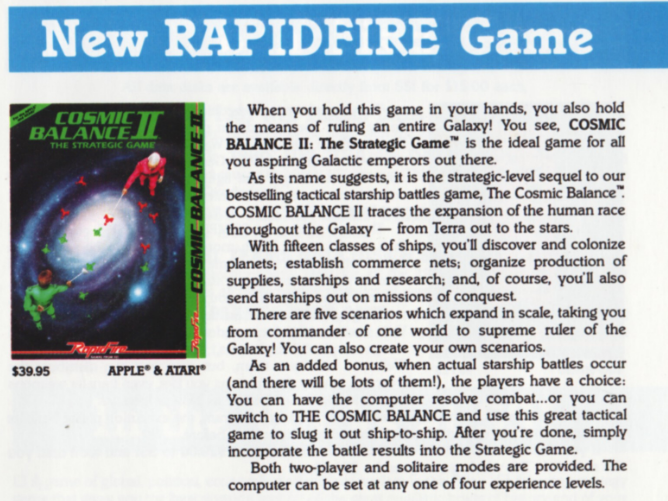
For Paul Murray, the designer of the series and at this point in time a permanent employee of SSI, there was just one problem. He had not designed The Cosmic Balance with a strategic layer in mind. Now he had to retrofit a strategic game that could generate all the tactical situations found in the first game including convoy interception and planetary bombardment. As Murray recounted in an email exchange I had with him, he had just read a sci-fi novel (whose title he forgot) in which an interstellar civilization had crippled its enemy by disrupting interplanetary trade. From this inspiration, he created the core gameplay of Cosmic Balance II and what makes it for better or for worse absolutely unique to this day : the split between the agricultural, mining and industrial planets, useless alone but valuable when combined into commerce nets. With that, Murray had his convoys, planetary raids and patrols. With the skeleton designed, he added a few more features to match the ones from the Cosmic Balance, and hoped for the best.
Did it work ?
Well, no, according to Murray himself. Long before I started playing Cosmic Balance II, when I was still chatting with him about The Road to Gettysburg, Murray told me (reproduced with his graceful authorisation) :
“I would never call myself the kind of designer who did deep research. I just made up rules that seemed like they would work together to get the feel I wanted. Sometimes that worked and sometimes I ended up with VisiCalc in Space.”
The “VisiCalc in Space” reference comes straight from a particularly scathing “editor’s note” in a Computer Gaming World review, and indeed there is something VisiCalc-y (or as we would say today : Microsoft Excel-y) about the game. The different menus, except for the galaxy map, are either lists or matrixes :
- list of ships in a sector,
- matrix of ships by mission,
- matrix of planets by type & colony level,
- matrix of planets by type & status (active/ecolapse/colony/discovered/enemy),
But of course, Cosmic Balance II is a lot more than a spreadsheet manager. I believe it is the first single-player PC 4X (“eXplore, eXpand, eXploit and eXterminate“) ever released. The earlier 4X were either
- effectively multiplayer-only (Andromeda Conquest in 1982), or
- only available on mainframe computers (Walter Bright’s Empire in 1977 ; and yes technically Bright released a Heathkit H-11 version in April 1983, but that version sold exactly 2 copies)
Furthermore, it can be argued that those two precursors games did not really have an “exploit” feature (planets/cities could not be improved), which would make Cosmic Balance II the first 4X without any qualifier.
And yet, most articles on the history of 4X shun Cosmic Balance II in favour of Reach for the Stars released two months later in July ; for instance Retrogamer in September 2014 called Reach for the Stars the “first sci-fi themed 4X game”. As I write even Wikipedia or Mobygames don’t have Cosmic Balance II in their lists of 4X games.
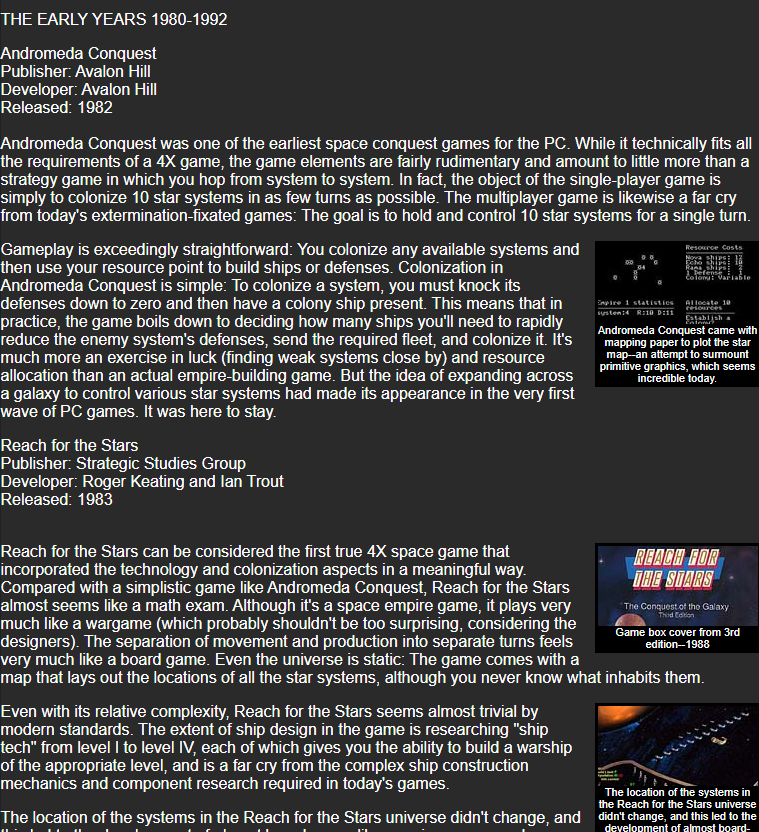
Cosmic Balance II being either forgotten or ignored is understandable. It is as if an evil djinn had cursed this game and subverted all the Xs into something sparking as little joy as possible. :
- Explore ? Scouting just means seeing the number of discovered planets increment in a matrix, as there are absolutely no differences within the 3 categories of planets you can find (industrial planets are converted from other types), and even then the Terran planets only appear 1% of the time. Moreover, the scenarios provided with the game did not make much use of the “scouting” feature anyway,
- Exploit ? Have fun typing the same commands turn after turn to colonize a planet, before typing the same commands turn after turn to order your cargo fleet to run commerce missions,
- Expand ? Where is the joy in conquering enemy planets which will bring 0 revenue, unless you conquer a perfect set of 10 planets and go through the painstaking exploit process above,
- Exterminate ? You don’t really pick your battles, and these are basically a “before” and an “after” screen – except if you use The Cosmic Balance tactical game, but let’s be honest I am pretty sure barely anyone did.
Indeed, the key selling point of Cosmic Balance II was playing the tactical battles with the first game, but while the option exists, I can’t imagine many players ever used it :
- First, no ship blueprint is provided, so you need to create your own destroyers, lancers, free traders etc. That’s 15 ships by tech level ; every time you level up in tech you will have to adjust your ships,
- Then, there are just too many combats every turn, and few are individually strategic, except maybe invasions of industrial and Terran worlds.
- Finally, the option to play tactical battles in The Cosmic Balance is chosen at the beginning of a campaign, and if you choose so you will have to answer the following prompt for every single battle. Tiresome.
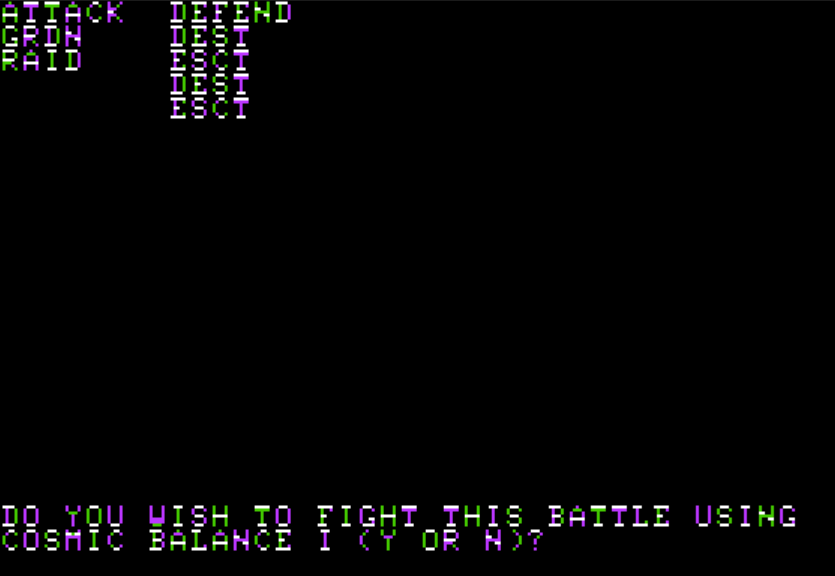
The output of tactical battles is not even that satisfying – the player must type manually the result of the battle. The only interesting feature is the fact that in tactical battles you can capture enemy ships, something that never happens in a normal game.
As inconvenient as using The Cosmic Balance as a “tactical adjunct” was, it had an unexpected consequence : it landed Cosmic Balance II in the RapidFire series. The game is certainly not rapid, but look, The Cosmic Balance was a RapidFire game so Cosmic Balance 2 had to be as well. Few reviewers failed to notice the oddity.
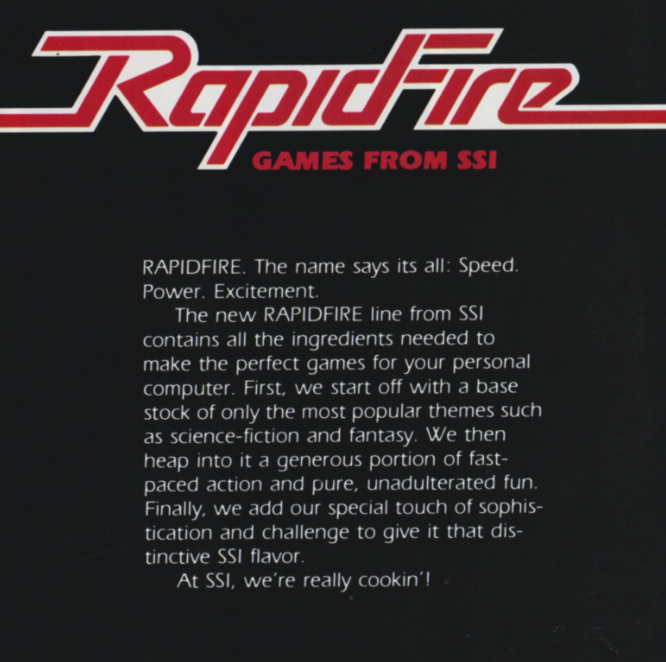
So, ratings :
A. Immersion
Very poor. The storyline is functional, but the game is extremely dry in gameplay and absolutely lacking any sort of art. At least it feels realistic in its own way.
B. UI , Clarity of rules and outcomes
Poor. UI is extremely easy to navigate. It is also easy to give orders, but boy is it long to do it every single turn for every single sector, with colonisation as the worst offender. Some automatisation (“allocate the required commerce and supply missions”, “resupply all planets”, …) would have been extremely welcome.
C. Systems
Very poor. In addition to everything I said, the game is really pulled back by the rigid “10 planets including 7 farms, 2 mines and 1 industry” rule. Making trade efficiency proportional to the size of the commerce net rather than just on or off would have made, in my opinion, the game much better while keeping commerce raids a critical feature of the game.
D. Scenario design and balancing
Very poor. I give the game some credit for having scenarios of increasing complexity and an aggressive AI that does not sprinkle its forces but instead focuses on specific targets every turn. However, the same AI is unable to do some basic actions (scout and colonize) so it only looks good thanks to the scenario design. Worse, its cheating on maintenance is obvious and nullifies a large part of what makes the game unique (high impact commerce raids).
E. Did I make interesting decisions ?
Yes, every turn in the more complex scenarios, but there was no joy in that. The game is too repetitive and not rewarding in any way.
F. Final rating
Totally obsolete
Contemporary Review
I already mentioned the Computer Gaming World‘s biting review. While “VisiCalc in Space” comment is actually an “editor’s note”, the reviewer James McPherson has a similar point of view : “I felt that CBII was too much like working on a balance sheet and watching the numbers change.”
Computer Gaming World‘s review is the harshest one I came across. Of course, the other contemporary reviews I could find (Softalk in September 1983, Compute! in February 1984 or Electronic Games in May 1984) warned their readers that the game was slow and not for everyone, but they always ended on a more positive note, noting how unique the game was, and even sometimes how realistic it felt. Even the French magazine Tilt gave the game 5 stars out of 6 in its March ’84 wargame retrospective.
Cosmic Balance II sold 5 200 copies in the US, compared to 13 000 for The Cosmic Balance. Not great, not terrible. It left Paul Murray dissatisfied, and he came back to the genre with Imperium Galactum in 1984 – a game NOT related to Cosmic Balance, even though Wikipedia claims the opposite. Between the two games, Reach for the Stars had been released (July 1983), and the space 4X genre had received its codifier.
That’s all for Cosmic Balance II. For the upcoming games, I just removed Molimerx’s Crusaders from the list ; I don’t have its manual and the game is almost impossible to play without it – trust me I tried because it looks quite interesting. William the Conqueror, also by Molimerx, is in the same situation. This means that I am now testing Reach for the Stars and two competitors of TAC : Operation Whirlwind and Combat Leader.
2 Comments
Very honest and interesting review. There were so many great 4X boardgame designs around at the time to draw on, and good design means everything, even given the restrictions to implementation on contemporary hardware. It really highlights the problems with ‘stream of consciousness’ coding, fun as it might be for the developer. Still, credits to Murray for some good ideas and aspirations. IMO he did much better with Imperium Galactum which blew my socks off for a few weeks back in its day.
All hail VisiCalc
…in space